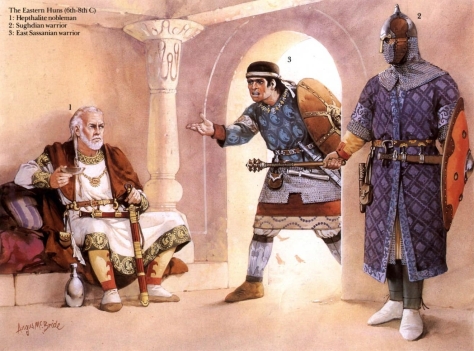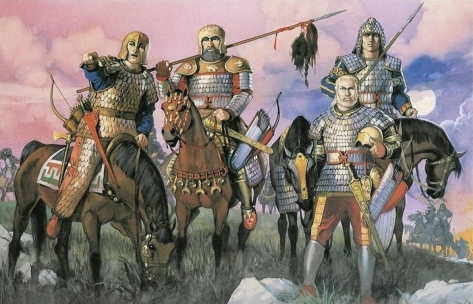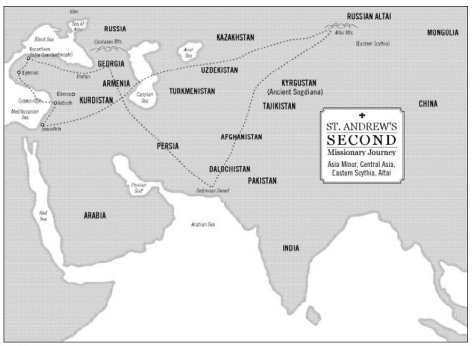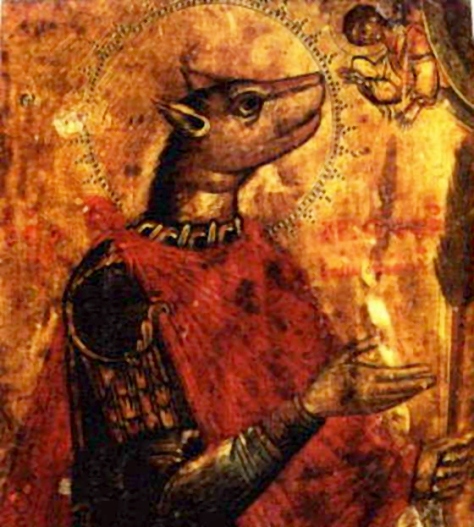Part One: Seas Red and Black
Andrew's second adventure was rather more ambitious than his first. After he reached Antioch, he caught a boat to Cyprus, then to Epheseus: from there he went back to Antioch, Nicaea, Pontus, and Armenia. Then, Andrew goes south through Persia, and reaches Gedrosia.
There he meets the Cynocephali... and this is where thing get a bit crazy.
Here is one account of this strange tribe:
On these mountains there live men with the head of a dog, whose clothing is the skin of wild beasts. They speak no language, but bark like dogs, and in this manner make themselves understood by each other. Their teeth are larger than those of dogs, their nails like those of these animals, but longer and rounder. They inhabit the mountains as far as the river Indus. Their complexion is swarthy. They are extremely just, like the rest of the Indians with whom they associate. They understand the Indian language but are unable to converse, only barking or making signs with their hands and fingers by way of reply, like the deaf and dumb. They are called by the Indians Calystrii, in Greek Cynocephali["dog-heads"]. They live on raw meat. They number about 120,000.
The Cynocephali living on the mountains do not practice any trade but live by hunting. When they have killed an animal they roast it in the sun. They also rear numbers of sheep, goats, and asses, drinking the milk of the sheep and whey made from it. They eat the fruit of the Siptakhora, whence amber is procured, since it is sweet. They also dry it and keep it in baskets, as the Greeks keep their dried grapes. They make rafts which they load with this fruit together with well-cleaned purple flowers and 260 talents of amber, with the same quantity of the purple dye, and thousand additional talents of amber, which they send annually to the king of India.
They exchange the rest for bread, flour, and cotton stuffs with the Indians, from whom they also buy swords for hunting wild beasts, bows, and arrows, being very skillful in drawing the bow and hurling the spear. They cannot be defeated in war, since they inhabit lofty and inaccessible mountains. Every five years the king sends them a present of 300,000 bows, as many spears, 120,000 shields, and 50,000 swords.
They do not live in houses, but in caves. They set out for the chase with bows and spears, and as they are very swift of foot, they pursue and soon overtake their quarry. The women have a bath once a month, the men do not have a bath at all, but only wash their hands. They anoint themselves three times a month with oil made from milk and wipe themselves with skins. The clothes of men and women alike are not skins with the hair on, but skins tanned and very fine. The richest wear linen clothes, but they are few in number. They have no beds, but sleep on leaves or grass. He who possesses the greatest number of sheep is considered the richest, and so in regard to their other possessions. All, both men and women, have tails above their hips, like dogs, but longer and more hairy.
They are just, and live longer than any other men, 170, sometimes 200 years.Now, before we start imagining St. Andrew meeting a hitherto undiscovered race of humanoid sentient canines, Mr Alexandrou offers his own theory as to who and what the Cynocephali were in a way that doesn't evoke memories of Dogtanian and the Muskethounds:
- Photius' Excerpt of Ctesias' Indica
Several sources say that St. Andrew was in this northeast region of Pakistan, and we know that there were peoples in this area who slashed their cheeks from mouth to ear, so that all the teeth showed. Marco Polo saw this tribe, whom he called the Cynocefaloi. He said that they looked like mastiffs; that is, they didn’t have elongated heads like German shepherds with the long nose, but like mastiffs. You can imagine – a mastiff has a round, flat face shaped more like that of a human. They cut babies so that they would grow into a very ferocious aspect. All of this was to protect themselves from the constant invasions of the area.
If you go to some sub-Saharan tribes today along the Nile in Rwanda, or along the Amazon, or in New Guinea, the faces of some tribal peoples can frighten you terribly. They systematically mold their faces into something ferocious – the shape of the head, cheeks, teeth... These people were ferocious in looks, but not ferocious in their ways. They were simply a primitive people who needed to protect themselves.
According to the Syriac text, when St. Andrew went to these people they were transformed into normal human beings. In my opinion this means that after their baptism they simply stopped doing these things. In Deuteronomy it is forbidden to scar or mutilate the face, so this would have been part of the apostolic heritage that St. Andrew taught to this people.
The Syriac sources say that when St. Andrew first saw them he was horrified. He panicked and fled back to the shore to jump into the boat, but as he reached the shore he smelled incense and realized that the Lord Himself had guided the boat there. He even questioned God at first, “Why did you bring me to this place?” (He is a man you know. St. Andrew is a man like all of us, but he is special.) But when the people came to him, they were kind, they gave him hospitality. They were just fine primitive people, as are many tribes in the Amazon today, even those who fight each other.
We hear of this nowadays from people who have come into contact with “barbarian” tribes with strange customs, according to our cultures. Because they accept these people, they in turn are accepted by them. In Papua, New Guinea, in the Amazon, in the jungles of Africa, these people often embrace westerners who settle and live with them in a matter we can hardly imagine, with real love and tenderness. This happened to the apostles as well. The real problem for the apostles was when they were in the “civilized” world, not amongst primitive peoples.It's an important point: all too often, Christian evangelism has been abused as part of the pernicious "civilising" of "barbarian" peoples. Even so, you have to wonder what it must've been like for a Galilee fisherman to behold such people as described by ancient hisstorians.
Of course, the Robert E. Howard fan in me wanders to rather more eldritch places, like the ghouls Conan faced in The Hour of the Dragon, which were themselves inspired by the beasts of Lovecraft, Dunsany, Sime, and, ultimately, Arabian legends of the ghūl. Howard loved to meld Christian lore with cosmic horror, exemplified by "The Cairn on the Headland," which featured the Cross of St. Brendan being used to banish the cyclopean alien horror that was worshipped as Odin. It's easy to imagine a "Howardian" take on St. Patrick casting the snakes of Ireland in a more blood-and-thunder style, so why not St. Andrew too? Retelling the lives of saints with emphasis on action, adventure, thrills and intrigue was a popular pursuit back in the middle ages, as we'll learn in an upcoming post.
But of course, even if the Cynocephali were not as monstrous as they might have appeared, the world was still a dangerous place, and he was on a mission. After his adventures with the Dog-Headed People, he went back inland: through the Pahlavan kingdoms to the great Silk Road - the glorious cities of Samarkand and Bokhara, then in the land of Sogdiana - and possibly even to the western reaches of China. Howard fans may note another familiar name there: "Lord of Samarkand" chronicles the adventures of Donald MacDeesa, a roving Scotsman who finds himself in the court of mighty Timour. Scottish adventurers in far-off climes are well-attested in folklore and history, so it seems only appropriate that the patron saint of a nation of travellers does so too.
 |
|
The Proto-Bulgarians who followed the Huns even had a church dedicated to St. Andrew, although after later invasions they had to be re-Christianized. Also we have the Hephtalit Huns, a barbaric Turcik tribe who were the first Christian nation in central Asia (third-fourth century).
It is very important to understand that there are three separate traditions of St. Andrew’s missionary journeys to western China, eastern-central Asia, and Kalbin (Khalbinski Hrebet, a mountainous area on the borders of present-day Kazakhstan, Mongolia, and Russia.) One of these traditions is from Kazakhstan, another is Syriac, and the third is from the Bulgars of the Russian steppes, who migrated through Greece and eventually settled in Italy, filling their villages with churches dedicated to St. Andrew.Yet still Andrew travelled north, beyond the land of the Soghdians, to the ancestral lands of one of the fiercest warrior peoples of antiquity - the Scythians.
 |
|
The route from Sogdiana to the land of the Massagetae was a route that Romans, Jews, and Greeks didn’t use. It was a road that the nomadic tribes used when they collected payments from the Chinese for protecting the Silk Road. Regional traditions say that St. Andrew was there, and he seems to have been accepted by these nomads, who were considered to be some of the most savage people of that time.The Scythians were an Iranian-Eurasian culture of fierce horse nomads who roamed the vast steppes north of the Black Sea. They terrorised the Greeks, Romans, Persians, and the Dynasty, laid the foundations of the Silk Road, and were part of the host which destroyed the mighty Neo-Assyrian Empire. They were a warrior culture to a man and to a woman, with no less than a third of female Scythian remains found buried with weapons and bearing war-wounds. Now, early Christian missionaries didn't have the strength and wealth of a church to support and defend them: they frequently ended up beaten, hounded, and martyred - and that's the "civilised" people of the Mediterranean, as Mr Alexandrou mentioned earlier. Still, for Andrew to go north beyond the limits of the Greco-Roman world to bring the Word to a people infamous for their savagery must've been gallous indeed.
If you think the Scythians might sound a bit familiar, well, they also make an appearance in... the Declaration of Arbroath!
Most holy Father and Lord, we know and gather from ancient acts and records, that in every famous nation this of Scotland hath been celebrated with many praises: This nation having come from Scythia the greater, through the Tuscan Sea and the Hercules Pillars, and having for many ages taken its residence in Spain in the midst of a most fierce people, could never be brought in subjection by any people, how barbarous soever...Eventually, Andrew decided to go back home: however he navigated his way back, he had a long way to go. But he was only halfway through his journeys...
Part Three: In The Country of the Man-Eaters
Part Four: The Cross on the Ice
Part Five: The Outermost Ends of the Earth
Part Six: A Cave in the Realm of the Wolf-People
Part Seven: "This Day A Martyr Or A Conqueror!"
Part Eight: Martyrdom in the Land of Lost Gods
Part Nine: The Scotland Yet To Come


No comments:
Post a Comment